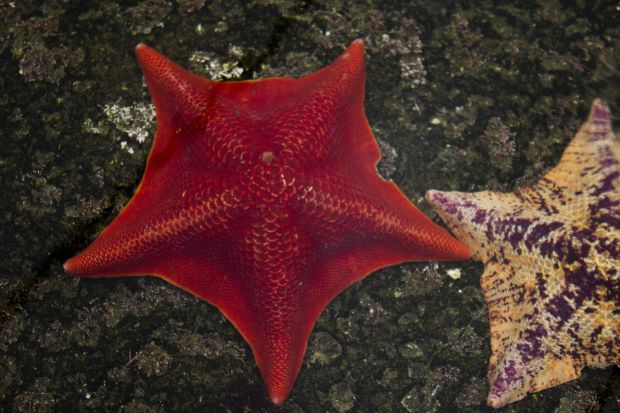
From Alaska to Malibu to the Mexican border, the starfish population has been nearly obliterated.
The epidemic was first observed in Washington last June and attributed to a mysterious “wasting” disease in which an organism’s tissue wastes away. The crisis has wiped out starfish, or sea-stars, along most of the west coast over the past year.
As a result, it could be quite a while before Malibu residents or tourists see big starfish again in the tidepools at Leo Carrillo State Beach, Point Dume and other rocky outcroppings along the shore.
Scientists are working quickly to figure out what’s causing the starfish to waste away into a pile of “goo,” as one called it, but there seems to be no cure in sight.
Carol Blanchette, research biologist at UC Santa Barbara’s Marine Science Institute, is monitoring intertidal sea-stars all across Southern California, including the sites in Malibu.
“We’ve lost most of the sea-stars at most sites across Southern California, including Malibu, but we’re seeing some juvenile stars at several sites,” she wrote in an email. “I’m at a conference in Oregon now discussing what might be causing the disease, but we still don’t know what the pathogen is, and we don’t know much about the role of environmental stress.”
The disease, dubbed “sea-star wasting syndrome,” is the most extensive sea-star wasting event on record, covering a larger geographic area and affecting more species of starfish than any other such event. Sea-stars afflicted with the disease become soft, develop lesions, start losing limbs and fall apart. Some describe them as “melting…turning to slime.” Starfish generally have the ability to grow new arms, but not in these cases.
“Wasting syndrome has been known for decades, but usually occurs in small numbers in southern California, and is linked to warmer ocean temperatures, which is not the case this time,” Pete Raimondi, leader of the Pacific Rocky Intertidal Monitoring Program told the Orange County Register last month. “The disease is typically isolated to one or two starfish among hundreds in a rocky tide pool. And even in bad cases, it rarely stretches beyond a single population. The extent of this is unprecedented.”
The disease has worked its way down the coast, first wiping out large colonies of starfish in Northern California, entering Southern California by November. Studies show that starfish in the rocky intertidal zones (tidepools), are just as hard hit as those living on the ocean floor.
The spread has even reached the state’s aquariums, with die-offs reported in both Monterey Bay Aquarium and Long Beach’s Aquarium of the Pacific.
A UC Santa Cruz statement issued in May said, “One of the top priorities is to confirm that an infectious agent is involved. DNA sequencing to identify possible viruses or bacteria is underway at Cornell University… [In addition], there’s no evidence that links the current wasting event to the ongoing disaster at the Fukushima nuclear facility in Japan.”
PBS News Hour reported just last week that scientists now believe a pathogen spreads through the water and by physical contact, since starfish often clump together. Another theory is that the pathogen is in mussels and clams that starfish consume.
With scientists predicting an El Niño event this year, Raimondi fears that the warmer ocean water could cause a pathogen to become more virulent and kill off more starfish.
At this point, scientists at least hope to make the best of a bad situation – they’ll either be able to study the ability of starfish to recover from the massive die-off, or else learn what effect the disappearance of starfish have on ocean and intertidal ecosystems.
Sea-stars are an apex predator in the intertidal zone.
“Voracious eaters and a keystone species. Losing a predator like that is bound to have some pretty serious ecological consequences and…we’re quite certain it’s going to have an impact,” said Blanchette.